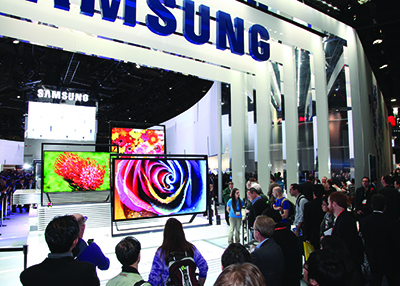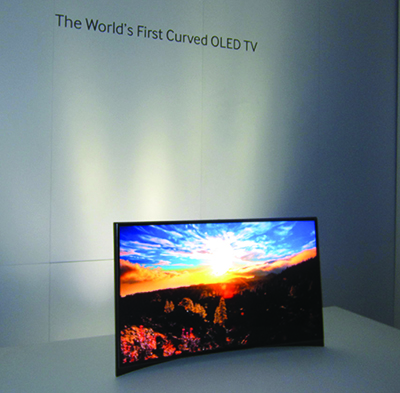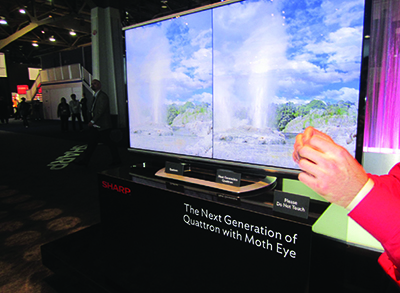CES Embraces the Big Picture

LAS VEGAS—Beyond the display screen duels (“largest,” “first curved OLED,” “most apps”), beyond crowning Julius Genachowski as “the spectrum chairman” and aside from the continuing questions about mobile broadcast TV viability, the 2013 International CES presented a complex vista about the changing television industry. The enormous electronics extravaganza also boosted the visibility of companies providing alternative TV user interfaces—ranging from gesture and voice controls to facial recognition and eyetracking— and especially focused on Internet-delivered video, which is increasingly integrated with linear video programming.
Although attendance was down slightly (150,000 compared to 2012’s record 156,000), the show set a record of 1.92 million net square feet of exhibit space, the equivalent of 37 football fields. More than 3,250 exhibitors displayed the latest in consumer products.
MEGA SCREENS, MEGA PRICES
CES’s major video initiative centered on Ultra High Definition TV (UHDTV), the 4K technology that displays images at four times the resolution of conventional 1080p HDTV. Every major manufacturer— Samsung, LG, Sony, Vizio, Panasonic, Sharp, HiSense and others—showed UHDTV products, emphasizing screens in the 60–84-inch range, which is considered the “sweet spot” for this level of higher resolution. When prices or delivery schedules were mentioned, the typical responses were $20,000–$25,000 (possibly dropping to $15,000 by year end) and fi rst shipments of the big new screens will start in spring.

Samsung (pictured) and LG both showed “world first” curved OLED screens—preproduction prototype monitors with a gentle concave curve that supposedly improves viewability off the center of the screen. Hisense, Samsung and Westinghouse all showed 110-inch UHDTVs, with Westhinghouse unveiling a price of about $300,000. Each one is custom made, according to a company spokesperson. Sharp unveiled a “dual” approach to UHDTV: Its new line of Purios models (starting with a 60-inch UHDTV set, due this summer), is the first set to receive THX 4K Display certification, the company said. Sharp is also using the UHD term for upgrades to its existing Aquos sets, and will sell Aquos UHDTV sets in the 50–55-inch range. A Sharp executive explained that these sets use a “next-generation Quattron” system that uses “sub-pixel signal processing” to double the resolution of one pixel which, he said, is “similar to Ultra HD at a lower cost.”
Sony is adding 55- and 65- inch 4K UHDTVs to its line-up, joining the 84-inch UHDTV it began selling last fall. LG Electronics showcased its 84-inch UHDTV, but also put a lot of emphasis on the smart TV features of existing LED models.
Tim Alessi, LG’s new product development director, acknowledged that “people who have smart TVs are not taking advantage of all the capabilities that they have.
“So we are making it easier and more convenient for people to get a lot more value out of their [Internet-connected] TVs,” he added. LG introduced its third-generation Magic Motion Remote, the gesturecontrolled system that uses technology developed by Rockville, Md.-based Hillcrest Labs. The new version will be able to control most cable TV set-top boxes, Blu-ray Disc players, soundboards and other home theater system components.
Get the TV Tech Newsletter
The professional video industry's #1 source for news, trends and product and tech information. Sign up below.
LG is also focusing on its support of Google TV as well as pushing the option to connect to second-screen devices including MHL compatibility in HDMI inputs across its entire 2013 line of TV sets.

Sharp demonstrated its new contrast-enhancing, glare-reducing motheye panel, which was demo-ed in a side-by-side comparison with a nontreated screen. Toshiba also emphasized its ’net connected TVs, pointing to its new “Cloud TV” servers that provide advanced interfaces, upgraded features and integration with smartphones.
“With our Cloud TV, we’re trying to make the TV more of a hub that brings not only content together, but people together,” said Scott Ramirez, Toshiba’s TV product marketing vice president.
Panasonic also joined the UHDTV parade, along with its emphasis on ’net-connected TV devices. To the surprise of many analysts, Panasonic unveiled five plasma TV models; the company had been expected to drop plasma to concentrate solely on LCD displays.
Meanwhile, in a battle of “firsts,” Samsung and LG both showed “world first” curved OLED screens—pre-production prototype monitors with a gentle concave curve that supposedly improves viewability off the center of the screen. Neither company offered a timetable or pricing for the curved screens.
OLED, 3D AND BEYOND
Organic Light Emitting Diode (OLED) technology continues to play a role in the display sector, although production problems continue to plague the business. A CEA official told TV Technology that OLED production yield is less than 20 percent. Nevertheless, both Sony and Panasonic said they each had the “world’s first 4K OLED TV” set in a 56-inch format. The companies also acknowledged that they are partnering to pool resources for their next assault on OLED production.
Since only LG, Samsung, Sony and Panasonic focused on OLED TV displays, a general opinion at CES was that OLED may find a better home in smaller device applications, such as tablets and smartphones.
While the overall CES emphasis was on 4K video, Sharp returned with its 85- inch 8K prototype and its eight-times- HDTV resolution. This was the same monitor seen at last year’s CES. A Sharp marketing manager indicated that there is no production timetable for the 8K displays.
3DTV—while greatly reduced in hype this year—is still part of the UHDTV story. Most TV makers showed UHDTVs with 3D capability as well as conventional HDTV displays with 3DTV options.
Dolby Labs demonstrated a new version of its “glasses-free 3D” displays, updating the technology it introduced at the 2012 NAB Show. “Several tier 1” (i.e. large) TV makers as well as flat-panel manufacturers and silicon vendors have “adjusted their roadmaps” for the no-glasses 3D technology, Roland Vlaicu, senior director for broadcast imaging at Dolby, told TV Technology. Although he declined to identify the companies, Vlaicu said that “several prototype TVs have already been submitted for Dolby’s approval process” and that “final products [may] arrive in late 2013 or early 2014.” No pricing or further distribution information is yet available.
Smart interfaces were ubiquitous throughout the show. In addition to LG’s Magic Motion remote “wand,” there were exhibits of other gesture and voice-control systems, many of them based on variations of Apple’s “Siri” voice recognition technology. Other companies tried alternatives, such as Chinese-based Haier, which introduced “Gaze TV.” Haier’s smart TV prototype, using technology from Tobii Technology, deploys eye-tracking hardware to provide—as Haier calls it—“a natural and effortless way to interact with the increasing amount of content” on smart TVs. No timetable for introduction was specified.
Among broadcast-centric products at CES was the new push for mobile TV, demonstrated by Dyle TV, the Mobile500 Alliance and a handful of suppliers. RCA’s new 8-inch tablet with built-in mobile TV receiver sat side-by-side next to ElGato’s $99 receiver that plugs into an iPad or iPhone. Audiovox Electronics also announced plans to develop a Dyle-enabled rear seat car entertainment system. While there was often significant traffic at the “Mobile TV TechZone,” there seemed to be continuing questions about the role of the service and the way in which it will be promoted after the Open Mobile Video Coalition organizing group is merged into the National Association of Broadcasters in coming months.
CLOUD AND INTEGRATION
Cisco introduced “VideoScape Unity,” which Jesper Andersen, senior vice president and general manager of Cisco’s Service Provider Video Technology Group, characterized as a unified system to “transform the experience of all content.” The package uses a “cloud DVR” to access streaming content from anywhere—including video, data and social media—to create an “immersive experience,” he said.
The Cisco demonstration focused on use of a “companion device”—an iPad— which was part of many companies’ descriptions of ways to personalize the viewing experience via recommendations across platforms and programs.
Many exhibitors on the show floor and in private suites showcased their latest visions of how video content can be discovered, navigated and recommended, either by trusted friends or automated navigation engines.
GENACHOWSKI’S FOCUS ON SPECTRUM
FCC Chairman Julius Genachowski, as he has done for several years during his CES appearances, spoke enthusiastically about the reassignment of wireless bandwidth. He confidently predicted that “more and more broadcasters are excited” about the incentive auctions, although he acknowledged that some TV station owners “would rather the process not happen.” Genachowski urged that both station executives and engineers “get the incentive auction right” since it will be a model for “the rest of the world,” which is also looking at TV spectrum reallocations.
CEA President/CEO Gary Shapiro, who conducted an hour-long on-stage discussion with Genachowski, characterized him as “the spectrum chairman” for expanding the wireless airwaves available for mobile and nonbroadcast services. Genachowski used the platform to unveil a plan to open up 195 MHz of spectrum for commercial use, all of it in the 5 GHz band and mostly coming from the Defense Department and other federal agency bandwidth assignments.
“We are convinced that the spectrum can be shared,” Genachowski said, emphasizing the need to resolve the “Wi-Fi traffic jam.” During a discussion about white spaces, the chairman said that even after the incentive auctions are complete and bandwidth is repacked, TV stations that remain in place will still have separations that could be re-assigned for other uses. Although not guaranteeing his prediction, Genachowski indicated that the spectrum revisions will be in place within the next decade.
Next year’s 2013 International CES will take place in Las Vegas, Jan. 7–10, 2014.
Gary Arlen, a contributor to Broadcasting & Cable, NextTV and TV Tech, is known for his visionary insights into the convergence of media + telecom + content + technology. His perspectives on public/tech policy, marketing and audience measurement have added to the value of his research and analyses of emerging interactive and broadband services. Gary was founder/editor/publisher of Interactivity Report, TeleServices Report and other influential newsletters; he was the long-time “curmudgeon” columnist for Multichannel News as well as a regular contributor to AdMap, Washington Technology and Telecommunications Reports; Gary writes regularly about trends and media/marketing for the Consumer Technology Association's i3 magazine plus several blogs.

